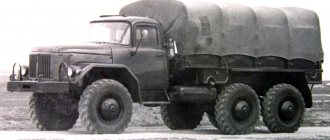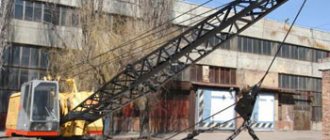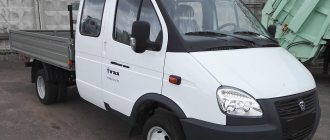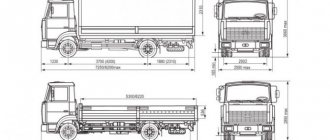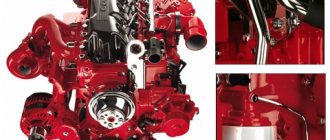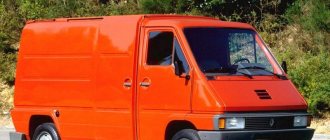Car history
Since 1962, the Likhachev Plant in Moscow has produced a truck for the national economy under the ZIL-130 brand. The truck was extremely popular and practical, but was inferior to its classmates due to high fuel consumption. At the end of the seventies, the plant began developing a more economical model with a diesel engine. Namely, in the 70s, the designers of the Likhachev plant received the task of developing two advanced trucks with different load capacities.
The models were supposed to run on diesel fuel. Initially, the car was designed by ZIL specialists, but after the design was created, the documentation was transferred to Naberezhnye Chelny. In 1986, the first ZIL-4331 began to roll off the assembly line. It was this model that was intended to replace the ZIL-130. Shortly after the launch of the project, the debut version of this model with a double cab was presented, as well as a chassis designed for special vehicles. Later, specialists from the Likhachev plant created a racing version of the truck, which resembled the original only in appearance.
How much does a ZIL 130 dump truck weigh for scrap metal?
Often people who have a car that has already served its purpose decide to sell it for metal. One of the frequently asked questions by such sellers is the following: “How much does a ZIL 130 dump truck for scrap metal weigh?” As a rule, a car can weigh up to 5 tons, and maybe no more than 500 kg if certain parts of it are rented out. The weight of ZIL is determined by the following factors:
- availability of all components;
- taking into account the percentage of non-metallic impurities;
- degree of vehicle pollution.
Thus, a full-fledged ZIL will weigh approximately 4.3 tons, if assembled. At the same time, when handing it over for scrap, you should be prepared that the acceptors will take away the weight of non-metallic parts, such as rubber, plastic and others, and also remove a percentage of contamination.
Thus, how much a ZIL 130 car will weigh can be found out by consulting with appraisers who weigh such types of scrap. Regardless of weight, scrapping ZIL is much more profitable and safer for the environment than throwing it in a landfill. The average cost of an assembled ZIL as scrap will be 10 thousand rubles, but the exact amount can only be found out after a preliminary inspection and weighing of the vehicle, taking into account non-metallic parts and the degree of contamination.
Purpose
The main area of application of the ZIL-4331 was regional transportation over short distances. The car is distinguished by reliability, ease of maintenance and repair, as well as low operating costs. It can be confidently called a “workhorse” for various industries, agriculture, logging, and housing and communal services. The car feels confident on sticky soils and steep climbs. The car performed well not only in various climatic zones of Russia, but also in subtropical and tropical climates. ZIL-4331 is equally reliable both on flat terrain and in high mountain areas. About one and a half million ZIL-4331 units are in operation in Russia and countries of the near and far abroad.
ZIL-169G cabin interior
0
Source:
The truck was equipped with a new ZIL-645 engine. This 8.7 liter diesel V8 has a power of 185 hp. and torque 510 N/m. As far as I know, according to a driver I know who has been dealing with this engine for a long time, it was even multi-fuel. The transmission is mechanical, nine-speed gearbox. The suspension remained spring.
0
Source:
A couple of years later, in 1976, the ZIL-7 E169 G appeared, with an extended cab.
0
Source:
There was no sleeping bag there, and in front of the doors, like an extension of the windshield, there were small vent windows. The hood and tail remain the same. In 1978, the truck acquired the final version of the cab appearance with which we all saw it on our roads. The truck turned out to be beautiful, in my opinion, of course, although many would argue.
Specifications
| Engine | ZIL-645 | ZIL-508.10 | ZIL-508.300 |
| Number of cylinders | 8 | 8 | 8 |
| Number of valves | 16 | 16 | 16 |
| Cylinder arrangement | Longitudinal V-shaped at an angle of 90° | Longitudinal V-shaped at an angle of 90° | Longitudinal V-shaped at an angle of 90° |
| Volume | 8.74 liters | 6 liters | 6 liters |
| Power | 185 l. With. | 150 l. With. | 135 l. With. |
| Maximum speed | 2,800 rpm | 2,800 rpm | 2,000 rpm |
| Maximum torque | 510 Newton meters | 402 Newton meters | 377 Newton meters |
| Dimensions | |||
| Length | 6 370 mm | ||
| Width | 2,500 mm | ||
| Height | 2,655 mm | ||
| Wheelbase | 4,500 mm | ||
| Front track | 1,930 mm | ||
| Rear track | 1 850 mm | ||
| Clearance | 330 mm | ||
| Dimensions of wheels | 7.0-20 | ||
| Wheel type | 9.00R20; I-N142B-1 | ||
| Weight characteristics | |||
| Truck weight | 4,820 kg | ||
| Maximum load capacity | 6 tons | ||
| Weight fully equipped and max. loaded | 11,700 kg | ||
| Weight of one fully equipped wheel | 93 kg | ||
| Engine weight | 720 kg | ||
| Engine weight with all equipment | 960 kg | ||
| Weight of the entire cabin structure | 550 kg | ||
| Maximum load | To the front axle | 3,735 kg | |
| To the rear axle | 8,005 kg | ||
| When using a road train with full suspension | 23,000 kg | ||
| Transmission | |||
| Type | Mechanics | ||
| Number of gearbox stages | 5 | ||
Engine
It is ZIL-4331 that is considered the founder of the first Russian line of trucks with diesel power plants. Fuel consumption of ZIL 4331 is from 18 l/100 kilometers. If we talk about a road train, then its consumption already starts from 25 liters per hundred. It is extremely rare, but still, you can find gasoline engines on trucks of the “4331” model. When operating a car with gasoline engines, consumption is approximately 30-36 liters per 100 km at a speed of 90-95 km/h and may vary depending on the load.
Transmission
The truck is equipped with rear axle drive. It has a single-plate clutch with peripheral springs. We also note that the clutch release drive is equipped with a pneumohydraulic booster.
Wheel formula
- 4×2
- 4×4
- 6x2
- 6×4
- 6×6
- 8x2
- 8x4
- 8x6
- 8x8
Load capacity
- 1-2 tons
- 2-5 tons
- 5-10 tons
- over 10 tons
Chassis
In the front part of the ZIL 4331 there is a pair of semi-elliptical springs with two shock absorbers and sliding rear ends. But at the rear, two main and additional springs of the same type are used.
Engine
ZIL 4331 was produced with 3 types of power plants:
- ZIL 508.10 – V-shaped 4-stroke gasoline engine. Characteristics: displacement – 6 l, rated power – 150 hp, maximum torque – 402 Nm, number of cylinders – 8, cylinder diameter – 100 mm, compression ratio – 7.1. The engine was liquid cooled and had a carburetor power system. It included a cast iron cylinder block. The operating life of the ZIL 508.10 engine is 350,000 km, the recommended fuel type is AI-76 gasoline.
- ZIL 508300 – V-shaped 4-stroke gasoline unit. Characteristics: displacement – 6 l, rated power – 134 hp, maximum torque – 377 Nm, number of cylinders – 8, compression ratio – 7.1. The power supply system is electronically controlled carburetor, the cooling system is liquid. The engine complied with the Euro-3 environmental class. Recommended fuel type is A-80 gasoline.
- ZIL 645 – V-shaped 4-stroke diesel engine. Characteristics: displacement – 8.75 l, rated power – 185 hp, maximum torque – 510 Nm, number of cylinders – 8, cylinder diameter – 110 mm, compression ratio – 18.5. The power system is diesel, the cooling system is liquid. The ZIL 645 diesel unit gave greater output, which compared favorably with the gasoline units used in the ZIL 4331.
Dimensions and weight characteristics
The car is relatively compact, its dimensions today allow it to be used in city conditions - most road structures will not become an obstacle in the way of this truck:
- total length from front to rear bumper – 6,370 mm;
- body width from the axis of the left rear-view mirror to the right - 2,500 mm;
- height from the tread to the side lights on the roof – 2,655 mm.
The wheelbase is also quite short for a car of this size:
- the distance between the front wheels is 1,930 mm;
- between the rear ones – 1,850 mm.
The ground clearance can please even the most demanding drivers and those who carry out transportation on extremely poor roads: its value is as much as 330 mm. The average track width is 1,930 mm.
The weight of the car itself is 4,820 kg (excluding refueling fluids). The maximum load that the ZIL-4331 can carry is 6,000 kg.
Thus, this truck cannot seriously compete with foreign analogues due to its rather high fuel consumption and low load capacity. But the ease of repair and low cost make the car in question extremely popular.
The total weight of the ZIL with a full load and filling fluids is approximately 11,700 kg. This weight can easily withstand most of the various bridges and other similar engineering communications on the roads.
ZIL 131 in tables and figures
ZIL-131 and its technical characteristics can be illustrated using the table:
| Curb weight | 6135 kg for modifications with a winch 6375 kg |
| Load capacity | 3.5 t on soil 5 t on hard surface |
| Permissible trailer weight | on the highway 6.5 t on the ground 4 t |
| Cruising range without refueling | 630 km |
| Highway speed | 85 km/h |
| Fuel system | 2*170 l |
| Fuel consumption | average 50 l/100 km |
| Wheel formula | 6:6 |
| checkpoint | 5-speed manual transmission |
Engine parameters:
| Type | Carburetor, 4-stroke, 8-cylinder with heater |
| Fuel type | Petrol |
| Volume | 6 l |
| Power | 150 l. With. or 110 kW |
Dimensions:
| Length from front bumper to rear edge of body | 7040 mm |
| Width | 2500 mm |
| Cabin height | 2480 mm |
| Awning height | 2975 mm |
| Ground clearance | 330 mm |
Known modifications:
| ZIL-131 | Basic (onboard platform) |
| ZIL-131A | Option with unshielded electrical equipment |
| ZIL-131V | Truck tractor for transporting large cargo weighing up to 12 tons |
| ZIL-131D | Military and civilian dump trucks |
| ZIL-131N1 | Version with 105 horsepower diesel engine |
| ZIL-131N2 | This version was already equipped with a 132-horsepower diesel engine |
| ZIL-131S | Version of the truck for the Far North: the cabin had an autonomous heating system, enhanced thermal insulation and double glass; frost-resistant tires were used on the car |
| ZIL-131X | Truck for steppe and desert landscapes, often with appropriate camouflage |
| ZIL-131-137B | Multi-link road train for particularly large shipments |
Cabin and body
First of all, the appearance of the cabin has changed. It acquired angular, clearly defined outlines without smooth transitions. The body is made entirely of metal and has a common base. However, its layout is not entirely standard. The main difference is that the fenders, hood and front grille are made from one rigid piece. Access to the engine is provided by lifting this structure up and forward on hinges that are attached to the front bumper on the vehicle's power frame. At the same time, it has become very convenient to repair the engine; access to all engine systems is available. Over time, this method was abolished due to some inconveniences in operation.
In subsequent versions of the model, the hood opens in the usual “alligator” way. At the front of the ZIL-4331 truck, a new front bumper is installed, into which headlights and turn signals are mounted. Moreover, they are structurally located in such a way that there is the least danger of damage in the event of an accidental collision. Inside, the cabin has become more comfortable. The comfortable driver's seat is sprung and adjustable in all directions. Two passengers can sit side by side. The middle seat lifts up to create a table. The large glass area of the cabin and side mirrors allow you to fully control the road situation. The ZIL cabin of the “4331” model is equipped with excellent heat and sound insulation, which allows you to talk inside the truck without raising your voice, and also not experience inconvenience due to cold weather. There are three seats, one of them is the driver's seat. One of the most popular was the modification with a berth, which appeared in the early 90s.
The model received a universal bumper “skirt”, fairings on the sides of the body and a drag foiler installed on the roof. ZIL-4331, in comparison with foreign analogues, stood out for its significantly lower cost. In addition to the cabin designed for three people, versions with a 2-row cabin version with 7 seats were also produced. The ZIL-4331 flatbed body is a wooden platform with metal transverse base bars, with folding rear and side sides. The body design provides for the possibility of installing extension sides and an awning with a frame.
Technical characteristics of the dump truck
The technical characteristics of the ZIL-130 car exceeded all expectations. A windshield washer appeared, the engine was heated before starting, and the cabin became a three-seater cabin. The car has become more comfortable.
Engine
The engine on the ZIL-130 is a v-shaped, eight-cylinder, 4-stroke “HORSE”. The working volume of the ZIL-130 engine is almost 6 liters, which, given its rather massive dimensions, is very economical.
Initially, the engine was a carburetor type, the overhead valve engine was intended for diesel fuel, but after 10 years of operation they began producing it for natural gas.
Table 1 - Technical characteristics of the ZIL-130 engine
| Name | ZIL-130 |
| Location | Longitudinal, front |
| Supply system | Carburetor |
| Cylinders, pcs. | 8 |
| Valves, pcs. | 2 |
| Volume, l | 5,99 |
| Power, hp | 150 |
| Rotation speed, rpm. | 3200 |
| Cooling | Liquid-air |
Improved synchronized rear-wheel drive gearbox (Gearbox) ZIL-130 with helical gears of constant mesh. Torque is transmitted to the rear axle, which provides more effective traction on asphalt roads or unpaved surfaces.
Table 2 — ZIL-130 gearbox design
| Gearbox | Mechanical |
| Number of speeds | 5 |
| Drive unit | Rear wheel drive |
Body
Depending on the modification, there were bodies with side and rear unloading. The height of the body was the same as the height of a railway car, which simplified loading and unloading of goods.
The volume of the ZIL-130 body is 5 cubic meters, and the platform area is 8.7 square meters. Due to the fact that the body volume of the ZIL-130 dump truck is quite large, it was sometimes used in agriculture, for transporting workers.
Brake system
Front, rear and parking brakes are standard, shoe, drum type. They are driven by pneumatics.
MTZ 82 technical characteristics: description, prices, video.
Compressor
All the air is in a special cylinder under pressure, which is produced by the ZIL-130 compressor. The compressor efficiency on the ZIL-130 is 220 l/min. at 2000 rpm.
Power supply
Electrical equipment ZIL-130 is single-wire. Power is supplied from a 12 volt battery at a current of 90 A/h.
Dimensions and load capacity
Table 3 describes the dimensions of the dump truck.
Table 3 - Dimensions of ZIL-130
| Length, mm | 6675 |
| Width, mm | 2500 |
| Height, mm | 2400 |
| Wheelbase, mm | 3800 |
The curb weight of the ZIL-130 is 9,360 tons, and the weight of the unloaded heavyweight ZIL-130 is 4.3 tons. The carrying capacity of the ZIL-130 dump truck varied depending on the model and dimensions of the cargo.
Initially, the maximum carrying capacity was 4 tons, but then reached 6 tons. The maximum load on the front axle is 2.625 tons, and on the rear axle - 7.9 tons, respectively.
Modifications
- ZIL-433100 - basic model with a wheelbase of 4500 mm and a ZIL-645 engine;
- ZIL-433102 – standard chassis;
- ZIL-433104 – chassis for fire trucks;
- ATs-3-40(433104) and ATs-40(433362)-63B.01 – fire tankers;
- ZIL-433110 – basic modification with the ZIL-508.10 unit;
- ZIL-433116 – basic version with the ZIL-509.10 power plant;
- ZIL-43314B - long-wheelbase flatbed version with a ZIL-6454 engine with a wheelbase of 6100 mm;
- ZIL-4332A - a special version with an extended wheelbase (5600 mm) and a ZIL-645 engine;
- ZIL-4333 - short-wheelbase modification with a ZIL-645 engine and a wheelbase of 3800 mm;
- ZIL-433302 – short-wheelbase chassis;
- ZIL-433360 – model with a shortened wheelbase and the ZIL-508.10 power plant;
- ZIL-433362 - short-wheelbase chassis equipped with a ZIL-508.300 engine;
- ZIL-442100 – truck tractor with a wheelbase of 3800 mm and a ZIL-645 unit;
- ZIL-442160 – truck tractor with a wheelbase of 3300 mm and a ZIL-508.10 engine;
- ZIL-442300 is a truck tractor with a sleeper and an extended wheelbase (4500 mm).
All versions of the model were characterized by a rear-wheel drive, front-engine layout.
The most popular modification
We are talking about ZIL-4333 . The shortened base was produced in the form of a truck and was equipped with three different engines: ZIL-645; ZIL-508.10 and ZIL-508.300. Certain changes added a prefix to the main index.
The appearance and structure were similar to the basic variation, only the length was not 6,370 mm, but 3,800 mm. These models have gained their popularity due to their practical size. It is more convenient to maneuver in city traffic with a shorter vehicle, and deliver cargo faster. Thanks to this, diesel variations 433302, 433360, 433362 are still produced.
Technical characteristics of the truck crane
The KS-2561D and KS-2561DA truck cranes were designed on the basis of the ZIL-130 dump truck chassis. The modified chassis is cable-type with a fixed linkage and folding outriggers.
This “BABID” is equipped with a double-row roller or ball bearing mechanism. The boom, due to its solidity, is lattice, because it does not have a retractable function.
Table 4 - Technical characteristics of truck cranes based on ZIL 130 KS-2561D and KS-2561DA.
| Base car | ZIL-130 |
| Base chassis power, kW | 110 |
| Switch installation | — |
| main | fixed boom |
| replaceable | with extended boom, with extended boom and jib |
| Main boom length, m | 8 |
| Reach, m | 3,3-7 |
| Load capacity, t | 1,6 |
| Load lifting/lowering speed | 0,2-5,3 |
| Rotation speed, rpm | 0,3-2,5 |
| Length, m | 10,6 |
| Height, m | 3,65 |
| Width, m | 2,5 |
| Weight, t | 8,8 |
Features and operation
The popularity of ZIL-4331 is largely due to its high reliability and simplicity of design. Even in the first models, the car received a spacious, sprung cabin with good visibility. Initially, the radiator grille, fenders and hood were raised at the same time, providing access to engine components and systems. However, in the event of a frame distortion or an accident, it became impossible to open the hood. This forced the designers to change the location of the engine attachments, and return to the more familiar design of the so-called “alligator” hood opening.
A distinctive feature of the ZIL-4331 is the headlights, side lights and direction indicators mounted in the bumper. The front part of the cab received a radiator grille made of plastic, which was a new solution for ZIL trucks. The cabin's finishing is far from outstanding, but in general, when driving inside, a low level of noise is created, allowing the driver and passenger to communicate without raising their voices.
The car is designed for operation in domestic conditions, so there are no problems with fuel and lubricants and consumables. In addition, you can use both domestic rubber and foreign-made tires of appropriate sizes.
Device
ZIL 130 has a fairly simple design. The front suspension is built on 2 semi-elliptic springs with shock absorbers and rear sliding ends, the rear suspension is built on 2 main and 2 additional semi-elliptic springs. These elements also received sliding ends.
The car has a rear-wheel drive axle and a dry clutch with a single disc. The ZIL 130 transmission is mechanical with one disc and a pair of synchronizers (for 2nd and 3rd, 4th and 5th gears). The 5-speed gearbox has a constant gear engagement with the exception of reverse and 1st gears. For the automotive industry of that time, this unit was considered new, but during its operation it changed several times. Torque is transmitted from the gearbox to the rear axle via a cardan shaft. For the ZIL 130 model, two shafts mounted on the frame were used. For versions with a shortened base, one shaft was used without an intermediate support. The first transmissions for the car were designed in 1961; 6 years later they underwent minor changes. In the restyled gearbox, the retaining ring was removed. The gear shift knob was insulated with a special rubber seal, which prevented moisture from entering the gearbox. The crankcase was made of high quality cast iron.
The braking system of the model consisted of drum-type brakes operating under the influence of a pneumatic system. A specialized tank with high pressure made it possible to maintain an air reserve. The parking brake used a drum that locked the driveshaft.
Electrical diagram of ZIL 130
The appearance of the ZIL 130 was very unusual for models produced in the 1960s, so the car immediately attracted the attention of others. The car received a non-military paint job for the first time. Previously, all the plant's products were khaki. Now there are modifications of white and blue colors. Streamlined fenders, an alligator-type hood and a panoramic windshield were prepared especially for the ZIL 130. Not all drivers were happy with this decision. Giving up the windshield did not happen right away. Another memorable element was the new shaped radiator grille.
